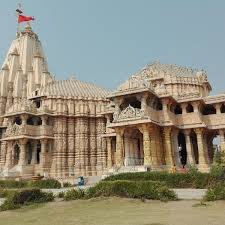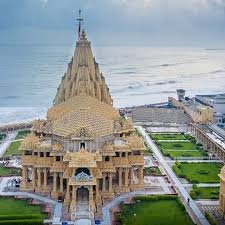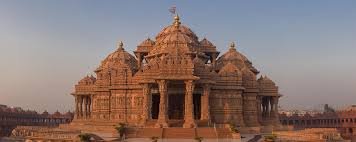
The Somnath Temple, located in the Prabhas Patan region of Gujarat, stands as a testament to India’s rich cultural heritage, resilience, and unwavering faith. Revered as the first of the 12 Jyotirlingas, the temple is dedicated to Lord Shiva and holds immense significance for millions of devotees. With its awe-inspiring architecture, legendary history, and spiritual ambiance, Somnath Temple attracts countless pilgrims and tourists from across the globe.read more about Somnath Temple Pilgrimage and Cultural Heritage.
In this blog, we’ll explore about the Somnath Temple Pilgrimage and Cultural Heritage the reasons why people visit it, and its financial importance, and its enduring legacy.
Historical Significance of Somnath Temple
- Ancient Origins
Somnath Temple has a history that dates back thousands of years, earning it the title “The Shrine Eternal.” According to legends, the original temple was built by Chandra Dev (Moon God) to atone for a curse. Over time, the temple has been reconstructed multiple times, reflecting its indomitable spirit. - Temple Reconstruction and Destruction
Over centuries, the Somnath Temple faced repeated destruction by invaders who sought to loot its wealth. For instance:- In 1025 CE, Mahmud of Ghazni plundered the temple for its riches.
- Later, rulers such as Allauddin Khilji and Aurangzeb also targeted it for its treasures.
- Modern Revival
Post-independence, Sardar Vallabhbhai Patel led the reconstruction of the temple in 1951. This modern structure, built in the Chalukya architectural style, represents both history and revival. Its imposing spire and intricate carvings are a marvel of craftsmanship.
Why Do People Prefer to Visit Somnath Temple?
The Somnath Temple attracts millions of visitors annually for several compelling reasons:
- Religious Significance
As the first Jyotirlinga, Somnath Temple is of immense importance to Lord Shiva’s devotees. Visiting the temple is believed to cleanse one’s sins and bring spiritual fulfillment. Moreover, many devotees embark on pilgrimages solely to seek blessings from the deity. - Spiritual Experience
The temple offers a serene environment that fosters a deep sense of peace and devotion. The chanting of mantras, the sound of temple bells, and the divine aura create a transcendental experience for visitors. Additionally, the temple’s location by the sea enhances its spiritual ambiance. - Architectural Grandeur
The modern-day Somnath Temple is an architectural masterpiece. With its imposing Shikhar (spire) rising 155 feet high and intricately carved stone walls, the temple’s beauty captivates visitors. Besides, the temple’s seaside location adds to its charm, offering breathtaking views of the Arabian Sea. - Cultural Heritage
Visitors are drawn to the temple not only for its religious significance but also for its rich history and cultural importance. Indeed, the tales of destruction and reconstruction serve as powerful reminders of India’s resilience. - Tourist Destination
For travelers, Somnath is not just a spiritual site but also a scenic destination. The temple’s seaside location provides stunning views of the Arabian Sea, making it a favorite spot for photography and relaxation .Furthermore, the temple draws visitors with nearby beaches and historical landmarks. - Connectivity to Other Holy Sites
Many pilgrims include Somnath as part of the Saurashtra pilgrimage circuit, which includes other sacred sites like Dwarka, Girnar, and Prabhas Patan. Consequently, Somnath becomes a must-visit destination for those on a spiritual journey.
Beliefs and Legends Surrounding Somnath Temple
The Somnath Temple is steeped in myths and legends, each adding to its spiritual significance:
- The Legend of Chandra Dev
According to mythology, Chandra Dev built the temple to worship Lord Shiva after being cursed by Daksha Prajapati. Lord Shiva forgave him, and the temple became a beacon of faith for devotees. - Sacred Jyotirlinga
The Jyotirlinga at Somnath is believed to be self-manifested, radiating an eternal divine energy. It is said that the linga holds immense spiritual power and fulfills the wishes of those who worship it with devotion. Therefore, people flock to the temple in search of divine blessings. - Gateway to the Triveni Sangam
The temple is located near the Triveni Sangam, where the rivers Saraswati, Hiran, and Kapila meet the Arabian Sea. This confluence is considered highly auspicious for performing rituals and seeking liberation. Moreover, the site is believed to be a gateway to the heavens. - Shiva as the Protector
Devotees believe that Lord Shiva protects the temple from any harm. The temple reinforces this belief by withstanding centuries of invasions and natural calamities.
Funds and Economic Significance of Somnath Temple
The Somnath Temple is not just a spiritual hub but also a significant contributor to the region’s economy:
- Temple Revenue
The temple receives substantial donations from devotees. These funds are managed by the Shree Somnath Trust, which oversees the temple’s administration and development. Moreover, the trust uses the funds for maintaining the temple’s grandeur and organizing events. - Boost to Local Economy
The influx of pilgrims and tourists generates significant revenue for local businesses, including hotels, restaurants, and transport services. This, in turn, supports the livelihoods of thousands of residents. - Employment Opportunities
The temple indirectly employs a large workforce, including priests, security personnel, maintenance staff, and vendors. Additionally, many locals earn a living by selling souvenirs, handicrafts, and religious items. - Development Projects
The temple uses the revenue it generates for social and infrastructural development in the region. For instance, the trust funds educational institutions, healthcare facilities, and housing projects for the underprivileged.
Importance of Somnath Temple
- Religious Importance
Somnath Temple is a vital spiritual destination for Hindus.Devotees consider it a gateway to Moksha (liberation) and a place to connect with the divine. - Cultural Symbol
The temple represents India’s rich cultural and architectural heritage. It serves as a reminder of the country’s ability to preserve its traditions despite adversities. - National Pride
People viewed the temple’s reconstruction post-independence as a moment of national pride. And is symbolizing the resurgence of India’s cultural identity. - Tourist Attraction
The temple attracts travelers from around the world, drawing them with its historical significance and scenic beauty. - Educational Value
For history enthusiasts and students, the temple offers a treasure trove of information about ancient Indian architecture, mythology, and resilience.
Conclusion
In conclusion, the Somnath Temple is not merely a place of worship but a symbol of eternal faith, resilience, and devotion. Its rich history, legendary myths, and architectural splendor continue to inspire awe and reverence among millions. Whether it’s for seeking spiritual solace, marveling at its beauty, or understanding India’s cultural heritage, a visit to Somnath Temple is a transformative experience.
For devotees, Somnath is a divine connection to Lord Shiva, and for tourists, it’s a journey into the heart of India’s timeless traditions. Indeed, the temple stands as a shining beacon of spirituality, resilience, and national pride. Somnath Temple Pilgrimage and Cultural Heritage is pride of india.
Om Namah Shivaya!





